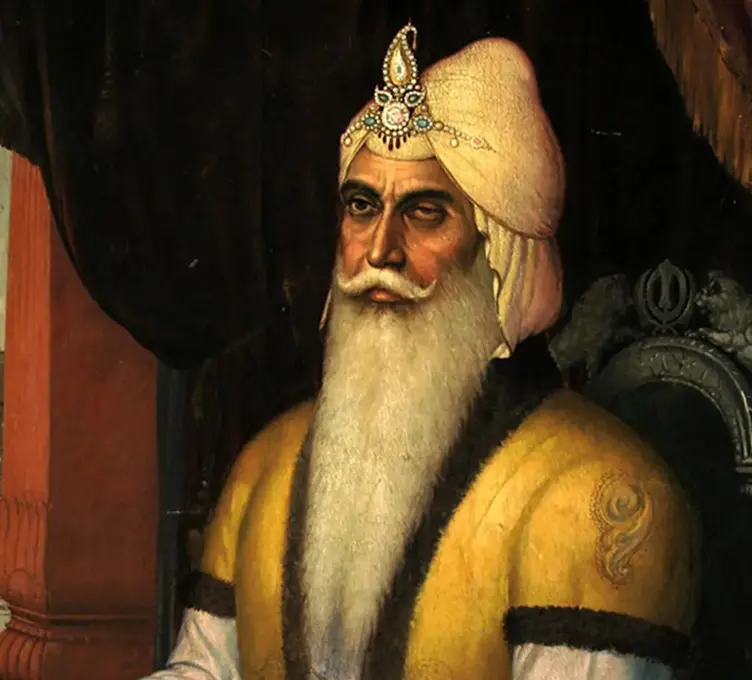
Inner Own Peace

of the Middle Way

for Everybody
Maharaja Ranjit Singh

Maharaja Ranjit Singh, The Founder Of The Sikh Empire
Early Life
Ranjit Singh was born on November 13, 1780 in Gujranwala, Punjab to Maha Singh and Raj Kaur. His father was the commander of the Sukerchakia misl (confederacy) and controlled a territory in the Majha region between the Sutlej and Beas rivers. Ranjit Singh contracted smallpox as an infant which resulted in the loss of his left eye.
In 1799, Ranjit Singh succeeded his father at the age of 19. He began consolidating the disunited Sikh misls to establish an independent kingdom.
Starting with the capture of Lahore in 1799 and Amritsar in 1802, Ranjit Singh gradually united the entire Punjab region under his rule through a combination of conquest, alliances and treaties.
By 1820, the boundaries of his Sikh Empire extended from the Khyber Pass in the west to Kashmir in the north, Sutlej river in the east and Multan in the south.
Secular Rule
As a ruler, Ranjit Singh distinguished himself for his secular outlook and tolerant governance. Though a Sikh by faith, he did not allow religious bigotry to dictate his state policies.
Ranjit Singh appointed talented administrators and generals based on merit rather than religion or ethnicity. His cabinet included trusted Muslim advisors like the Dogra brothers Faqir Azizuddin and Fakir Imamuddin.
He also recruited European officers to train his troops in Western warfare techniques.
Ranjit Singh ensured his subjects enjoyed prosperity irrespective of background or belief. He abolished discriminatory taxes levied on non-Muslims and granted patronage to indigenous arts, culture and places of worship.
Places of pilgrimage like Nankana Sahib and Panja Sahib received considerable funding under his reign. Hindus, Muslims and Sikhs were treated alike and given important positions. Interfaith harmony prevailed in the kingdom.
Military Conquests
Ranjit Singh proved himself to be an astute military strategist and built a well-trained professional army. His forces brought the powerful Pashtun tribes and kingdoms of Multan, Peshawar, Kashmir, Kangra-Jammu and Derajat under Sikh suzerainty through hard fought campaigns.
The Battle of Attock (1813) dealt a decisive blow to Afghan ambitions by capturing the strategic fort across the Indus. In 1818, Kashmir was annexed after defeating its Afghan rulers.
The most formidable Afghan ruler, Dost Muhammad Khan of Kabul, was defeated and compelled to cede major territories to Ranjit Singh.
At its peak, the Sikh kingdom had the most powerful and modern army in Asia.
Ranjit Singh employed French and other European officers to modernize his artillery and infantry. He fully utilized military technology innovations of the early 19th century in warfare.
Administration and Infrastructure
Ranjit Singh instituted an efficient administration divided into four provinces – Lahore, Multan, Peshawar and Kashmir. Each province was ruled by a governor aided by finance and taxation officials.
A standing army of 50,000 troops maintained law and order. Agriculture was encouraged while trade and commercial ties opened up.
New canals provided extensive irrigation enhancing the productivity of Punjabi fields.
Ranjit Singh sponsored infrastructure projects like laying of metalled roads and planting trees along highways. Coins were standardised using Nanakshahi currency and postage stamps introduced.
Major cities like Amritsar, Lahore and Multan underwent extensive development. Ranjit Singh also built up the holy Sikh shrines. Through such welfare measures, Ranjit Singh proved himself worthy of the title ‘Maharaja’.
Legacy
At its zenith in 1839, the Sikh Empire spanned over 200,000 square miles, providing unity and stability to the Punjab after centuries of turmoil.
Ranjit Singh came to power at a young age and built a strong kingdom through determination. He successfully defended Punjab from external aggression and ensured cultural integration and economic prosperity. His reign marked the golden period of Sikh history.
Maharaja Ranjit Singh died in 1839 from complications of a stroke. He was succeeded by his youngest son, Maharaja Kharak Singh.
The secular governance and military brilliance of Maharaja Ranjit Singh evoked admiration from contemporaries like French historian Jean-Baptiste Joseph Gouraud.
To this day, he remains an iconic figure in Sikh history and is considered one of the greatest native rulers of India. The spirit of religious tolerance and just rule exemplified by him holds valuable lessons.
The British Museum in London has a collection of artefacts belonging to Maharaja Ranjit Singh that provide insights into the Sikh ruler’s reign.
Some key artefacts on display include
Portrait of the Maharaja
This approximately 10 feet tall painting depicts Ranjit Singh sitting on a golden chair, wearing a shawl embroidered with pearls and precious stones. It gives a sense of his grandeur.
Gold bracelets and armlets
These ornate bracelets and armlets featuring animal designs were part of the Maharaja’s personal jewellery collection, reflecting his wealth.
Ceremonial sword and shield
The khanda sword and kawar shield embossed with gold designs were part of the arms and regalia of Ranjit Singh as head of the Sikh kingdom.
Gold coins
The exhibition features gold mohurs issued by Ranjit Singh’s mint struck in the name of the Guru. This shows his religious piety.
Marble jars
Intricately carved white marble jars from the Lahore fort highlight the sophistication of artisans under the Maharaja’s rule.
For Sikhs, visiting this exhibition at the British Museum provides insights into an important period of Sikh history and showcases the splendor, wealth and power attained under Maharaja Ranjit Singh.
